Search Results for Tag: ice
Exploring the North – Further North
Arriving in Tromso, Norway, we are now located just at the Arctic’s doorstep. It is a quiet strange feeling, when you suddenly stand at the edge of something, that is normally so incredibly far away. If it’s far away from you as well and you derive from that that you don’t have to care – hang on. You actually should, as the Arctic often is referred to as earth’s air conditioner. And on hot summer days without (working) air conditioning, you feel perfectly well what it is good for.

Thought you might have seen enough snow, so I found this Tromso view of June 2010 for you (Photo: CC-BY-NC-SA-2.0: Nietnagel)
If you look at such pictures of the Arctic region it does not at all like an air conditioning. I was actually suprised that it can be that green in the Arctic region, as I always associate of snow and ice with Artic. What about you?
But this ice is only there in winter time – that’s when it fulfils it’s cooling job, by reflecting 80 percent of sunlight back to space which then cannot heat up the ocean or earth anymore. But from March on, ice starts melting due to increasing temperatures. The decreasing sea ice cover uncovers the dark oceans that absorbs the sunlight instead of reflecting it – the cooling air conditioning turns into a heating facility.
So far, the Arctic yet hasn’t been completely ice-free during the warm summer period. But you might remember scientists worrying last summerabout the small area that is left ice covered: The larger the ice free part, the more heat is absorbed by the ocean underneath – in turn, even more ice melts and a vicious circle starts.
Not on the edge of the Arctic, but on the edge of Arctic research, you find scientists working on how this influences the Arctic environment. Sometimes this influence can even be positive: Researchers recently found that microbes in the soil can fix more carbon in a warmer climate.
But yet, researchers cannot tell how Arctic ice cover will evolve, but they work for example on better models to predict what is going to happen. That is especially important, as many earth systems are connected: A warming Arctic sea also affects ocean currents for example, that – connected to each other – span over the whole planet. In turn, oceans take up less CO2 for example, and in consequence more of this greenhouse gas in the air, warms up the whole planet.
Exploring the North – treasures under the ice cover
Our Global Ideas reporter Gianna Grün recently made a trip to the Arctic Circle and has written about tracking reindeer, an encounter with Sami herdsmen and sleeping in a hotel made entirely of ice. Check out her latest article from the freezing North.
What looks like a lovely winter wonderland landscape is in reality a perfect source for building material. No, I’m not talking about the few trees on the horizon – the resource slumbers below the snow cover! Hidden from the eye, the Torne river flows below the snow. Well, at least the part that’s not frozen. But the more interesting part is the ice cover. In March, i’s thick enough for ice block harvesting to begin.
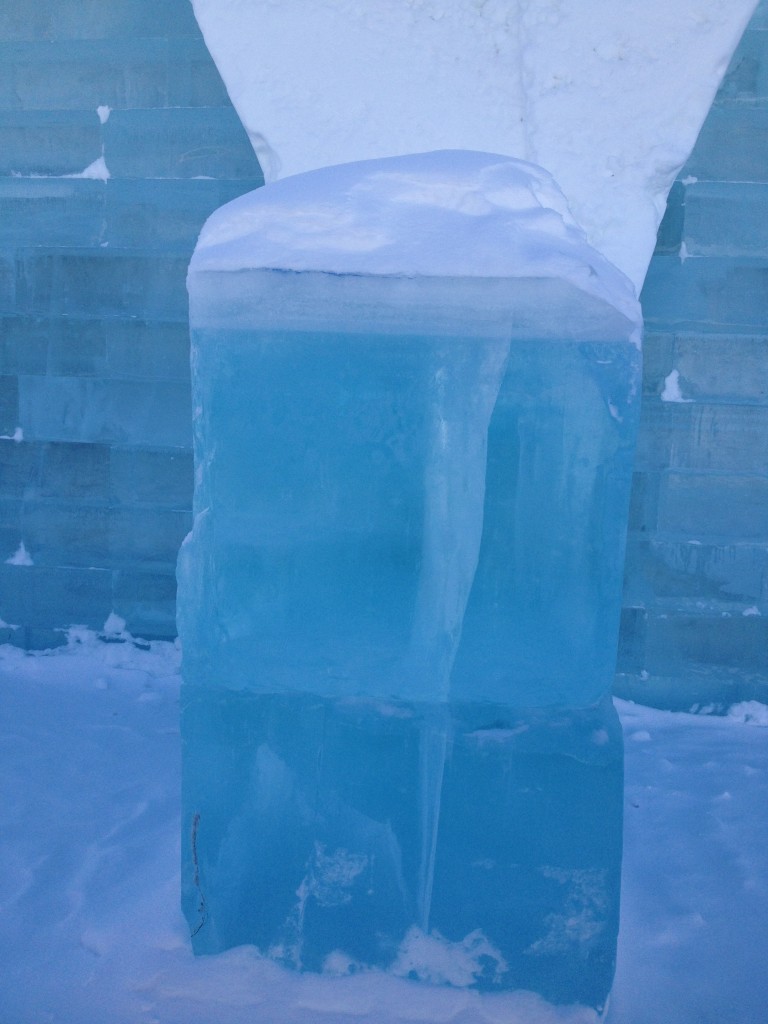
Ice blocks of such a size are hacked out of the Torne river in March and April each year. One block weighs 1.8 tons.
Some 2,500 of such 1.8 ton blocks are cut out in March and April to build a new hotel made of ice near Kiruna, Sweden. When spring arrives in other parts of the world, the ice is in perfect condition for building a new hotel from scratch next winter. The ice is at least 80 centimeters deep and crystal clear due to the high water quality of the Torne river and its perfect velocity and depth. Upstream, the water flows too fast and stirs up sediment from the river floor. Downstream from here, the water is too still and lacking in oxygen so you get milky ice.
Though it is quite cold up here in the North, building doesn’t begin right after harvesting. While the old ice hotel is literally melting, the 5,000 tons of newly harvested ice are stored over the summer. From April until October, the storage hall is cooled to minus six degrees Celsius. That requires almost 240,000 kilowatts of energy, which comes from renewable sources. Between November and March, no cooling is required since the outside temperature is cold enough. Thanks to the massive blocks of ice and the isolation, the entire place stays cool enough.
When construction begins in winter, the ice hotel builders arm themselves with electric irons and smoothers. Well, not for cleaning their teeth or ensuring wrinkle-free shirts, but for the fine tuning. After chain saws, tractors, snow cannons, snow throwers, wheel burrows, spades and chisels have got the basics in place, the finer details, embellishments and sculptures are readied to give the whole space a cozier feel despite the cold.
It takes six to eight weeks to set up the whole hotel. Apart from ice, a special mixture of ice and snow called “snice” is used as a kind of mortar. In addition, some wooden structures are built in the ice to support the very high and steep arches and a few reindeer skins cover some surfaces.
Apart from offering visitors the unusual experience of sleeping in a room surrounded by ice, the hotel is also trying its hand not just at cutting its carbon output but actually becoming CO2-negative. So far, it’s reduced overall energy consumption by 20 percent. But in future, it aims to cut CO2 in its immediate surroundings by an amount that exceeds its overall energy consumption.
Do you know of similar projects that use building materials lying right at the doorstep, without harming the environment?
Exploring the North – Sleep surrounded by ice
No matter where you are on the planet, in which country you live and where you’re reading these lines – once a day (at least), we all do the same thing – go to sleep. But some places offer more unusual environments than others to nod off. For instance, how about falling asleep surrounded by ice?
That’s exactly what I tried out at an ice hotel in Sweden. Even the idea of sleeping at about minus five degrees Celsius seems to awake some old evolutionary instincts (at least in people who are lucky enough to normally sleep in a warm bed at room temperatures around 20 degree plus). I actually felt a bit worried that I might not wake up (though the biologist in me knows all too well that if temperatures fall too far, you’ll just lose consciousness while sleeping and won’t even realize when you’re freezing to death). But I kept telling myself that all the other people who stayed here survived and that the polar sleeping bag will be warm enough.
It’s eerily quiet within each room in the hotel made of ice. That might be because of the contrast between sensual temperature feeling that tells me I must be outside, because it is so cold – and my auditive impression to be inside though. The rooms have actually no door, just a curtain and no bright light either. Just a more artistic green-bluish light installation that’s meant to imitate the Northern Lights. It’s an atmosphere that’s calming and oppressive at once.
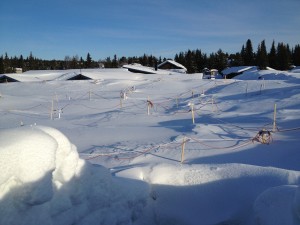
Lying in the room of ice on a bed made of ice (and a fur in between), wrapped up like a caterpillar in the sleeping bag, I’m watching myself falling asleep, meticulously noting the temperature of all body parts. In fact, 95 percent feel warm. The only cold part is the one that is not covered by the sleeping bag – my face. I can pull the bag tight so only my eyes, mouth and nose are uncovered. It feels a bit like an ice cube wandering over my skin, slightly cooling the surface.
Of course if you’re really tired, you can doze off under any circumstances. And while asleep, I sometimes have brilliant ideas like pulling my cap over my eyes and my scarf over the mouth. Even the biologist in me learned a lesson – waking up in the night because the lower sleeping-side is too cold. You actually register that and clumsily crawl onto the other side and fall asleep again as if you were in you own bed at home.
So what’s next?
Is ice as a building material a (literally) cool idea? Find out soon!
International Mountain Day
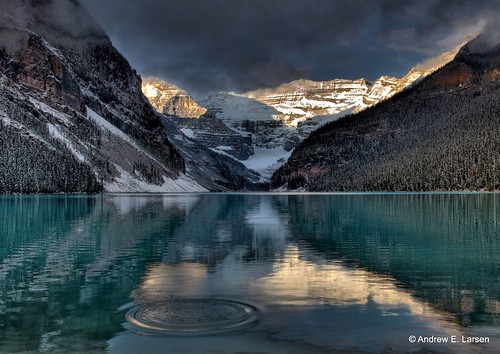 Despite their mighty appearance mountains are real softies -when it comes to the effects of climate change. Host to a variety of climates and weather conditions they are real biodiversity hotspots. But mountains and the life they sustain – human and animal – are particularly sensitive to climatic changes. Today, on International Mountain Day, The UN’s Food and Agriculture Organization (FAO) reminds us of just how important mountains are when it comes to protecting our climate.
Despite their mighty appearance mountains are real softies -when it comes to the effects of climate change. Host to a variety of climates and weather conditions they are real biodiversity hotspots. But mountains and the life they sustain – human and animal – are particularly sensitive to climatic changes. Today, on International Mountain Day, The UN’s Food and Agriculture Organization (FAO) reminds us of just how important mountains are when it comes to protecting our climate.
Is the ice-free north-pole just a matter of short-time?

Within this year’s summer period the arctic sea ice shield at the north pole melted dramatically to a new all-time low. The ice mass has fallen short of the record of 2007. And the low could get even lower, because the 2007 record was measured at 18 September. This year we saw the same record already in August. The ice usually melts until the mid of September and then starts again to grow during the winter period. But due to the large melting the new ice will be much thinner than usual. Scientists of the National Snow and Data Center explain that where have been an ice shield of a 3-4 meters just a few years ago, it’s possible to reach only 1-2 meters today. An ice free noth-pole could be the result, they say, followed by the irreversibility of the melting process. According to the Arctic Sea Ice Blog it’s just a question of when until we will see an ice free north pole.If you want to stay updated on that issue, there are lot’s of impressive and in somehow frightening opportunities. The picture on top of this post is provided by the Instituts for Arctic Climate Research at the University of Illinois. It’s going to be updated every day. So it will be possible to see the day the ice will be growing again. The website also offers a 30-day summary of the ice developement. You will also find tons of data about the planet’s ice shield’s via the National Snow and Ice Data Center.
But whats so bad about melting ice? Well, as Global Ideas Climate Expert Anders Levermann explained in one of his videos the arctic sea ice belongs to the earth’s tipping points. If the ice melts the dark ocean underneath will heat up and slowly melts even more ice. Here’s the video for you to see:



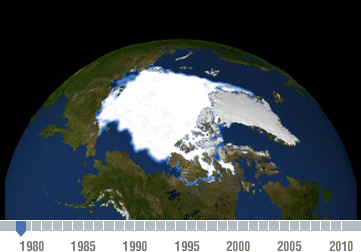




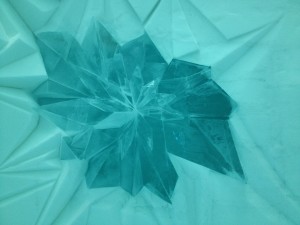
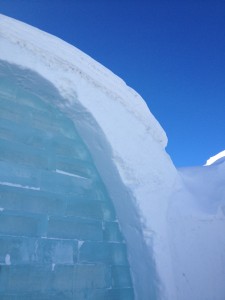




Feedback